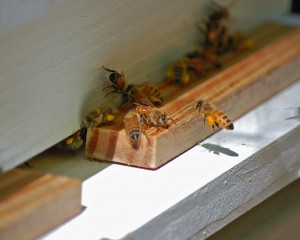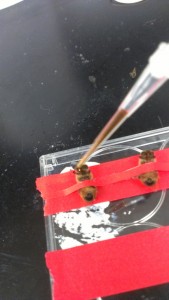Honeybees are hoarders, they accumulate good things like different types of nectar and pollen, but like hoarders there are some unintended consequences to bringing in all of that forage. That consequence is the accumulation of different pesticides. We also add to their pesticide load when we treat for diseases.

picture from: gardeningwithconfidence.com
A study of hive samples in 2007-2008 found as many as 39 chemical residues in a hive, an average of six residues across hives, and the presence of at least one type of chemical in 98 percent of hives!
To me this poses the question: how are the bees coping with these chemicals? We know that insects develop insecticide resistance through a variety of methods. They can chop the insecticide up once it enters the body using molecular cleavers called enzymes. They can also stick something to the insecticide to make it a target for removal, like putting a bulls eye on it.
There is increasing evidence that some insects, including honey bees, also have special transporters in their cells that prevent insecticides from building up to toxic levels, kind of like a bouncer at a club keeping the bad people out.
The interesting thing about these mechanisms is that insects can be rendered sensitive to insecticides again by simply co-exposing them to another chemical that prevents those cellular actions from working.
This has been shown in honeybees using products that are used to treat honeybee diseases. Feeding bees oxytetracycline (terramycin) has been shown to increase the toxicity of coumaphos and t-fluvalinate. It is not a big leap to imagine that some of the things bees pick up while foraging could also make them more sensitive to other chemicals.

As beekeepers we need to push for further study of chemical-chemical interactions, and not just test that the effect of a single insecticide on honey bees. We should always keep a close track of what we are putting inside of our hives, and be aware that mixtures of treatments could make the bees more susceptible to poisoning. We can’t control what the bees bring back into the hive, but we can try to be aware of what products are being used in nearby forage. This information is becoming increasingly more important for making hive management decisions.
Links to studies discussed on this page:
Killing them with kindness? In hive medications may inhibit xenobiotic efflux transporters and endanger honey bees.
http://www.plosone.org/article/info%3Adoi%2F10.1371%2Fjournal.pone.0026796
High Levels of miticides and agrochemicals in North American apiaries: implications for honey bee health
http://www.plosone.org/article/info%3Adoi%2F10.1371%2Fjournal.pone.0009754